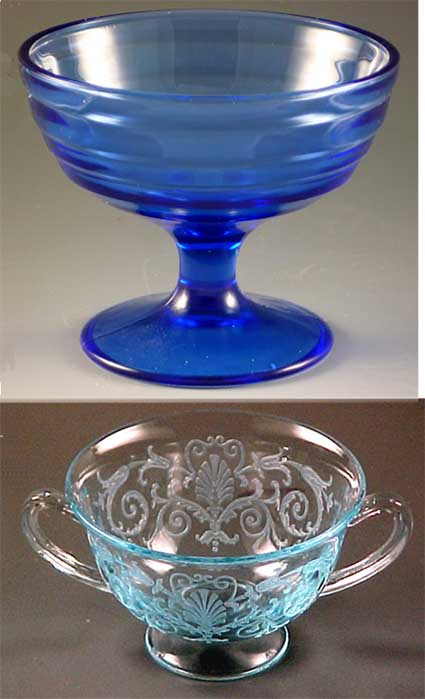
Beautiful blue depression-era glass came in every shade from the deepest cobalt to transparent azure and it remains one of the most popular colors. Let’s look at the glassware you can enjoy in your home.
Hazel Atlas made deep cobalt blue glass in several depression patterns, notably Moderntone, Aurora, Royal Lace, Newport, and New Century.
The gorgeous transparent deep blue sherbet in the photo is Moderntone. You can see the art deco influence with the simply raised bands and round shapes. Moderntone is one of the few blue depression patterns that you can find in a wide range of pieces. Moderntone is relatively available, especially compared to Royal Lace, and is probably the most affordable. Best of all, you don’t have to worry about reproductions with Moderntone, and – even more important – it is a wonderful design that looks great with others. Blue glass is often the most expensive color since so many people like it the best, yet Moderntone remains affordable. Only a few pieces cost over $80.
Aurora is a small pattern with only seven pieces. Oddly for such a small pattern, there are two sizes of bowls but the only plate is small, about 6 1/2 inches wide. It is one of my favorites for its simple banded style and interesting shapes. Hazel Atlas made complete sets in cobalt Newport and a few pieces of blue New Century but both patterns are scarce on the ground.
Hazel Atlas made Royal Lace from 1934 to 1941, producing pink, green, and clear first made the deep blue to use up glass originally destined for a different pattern. Collectors seek blue Royal Lace today, making it one of the most sought-after patterns and highly collectible. Royal Lace is a pretty pattern with a mold-etched design of flowers in panels between draped swags. It’s a lot of fun to collect over 30 pieces. Depression glass enthusiasts have driven the price up above the price of the equally beautiful green Royal Lace and higher than other patterns. If you choose to collect Royal Lace then please consider buying a reference book so you can be aware of the reproduction cookie jars and tumblers and learn how to distinguish real from repro.
Hocking Glass made the beautiful and very popular Mayfair Open Rose glassware in medium blue. This is scarce today. Reproduction companies made a few pieces including the cookie jar in a medium blue today so this is another pattern where would-be collectors should learn to spot the real glass. Hocking made a few pieces of Miss America and Princess in light blue.
Federal Glass, who made so many of our favorite depression era patterns in green, pink, and amber, made very little in blue. Their Madrid pattern came in a soft blue called Madonna Blue which is a medium shade. You can find later-made reproduction blue Madrid glassware where the blue color looks grayish.
Other companies made blue glass during the depression era. Look for Fenton’s Sheffield and Imperial’s Olive patterns in medium light blue glass that is exquisite. Both of these are less well-known so you may have to search a little because people may not know what they have to sell by pattern name.
Fostoria Glass made several etched patterns in medium dark blue in the late 1920s and early 1930s before switching to azure blue shade. Look for Royal and Vesper etched pieces in medium dark royal blue.
Fostoria made our beloved June and Versailles in a medium light blue. Both of these patterns are stunning. Fostoria used the Fairfax blank for stemware which has a clear stem and foot and colored bowl and there is a faceted knob on the stem that makes it easy to hold and gives that design punch.
June glass combines flowers with ribbons and bows and is exquisite and one of the best-selling vintage elegant patterns. Versailles has an etched central fan motif surrounded by lavish scrolls and swags. We have both patterns in our store Cat Lady Kate’s Elegant and Depression Glass. The photo shows a Versailles etched blue bouillon cup which is like a small cream soup.
Fostoria started making Baroque in light blue, about the same color as used for Versailles, at the tail end of the depression until 1943. You can find some etched patterns in blue Baroque, notably Lido which looks like poofs of milkweed. Fostoria etched Meadow Rose on Baroque which is a stunning combination.
Cambridge of course made many patterns in blue glass and made several shades of blue. Cambridge used their ten-sided Decagon blank for so many choice patterns. Cambridge called their blue used for Decagon Bluebell and it is very close in color to Fostoria’s Fairfax.
If you like blue glassware you have so much to choose from: Choose cobalt blue depression glass and enjoy art deco-influenced Moderntone or select the exquisite Fostoria June or Versailles etched azure blue. The choice is yours. This post was provided by Cat Lady Kate.
Discover more from Urban Art & Antiques
Subscribe to get the latest posts sent to your email.


Thank you for all of the GREAT information on glassware! Your site is definitely going into my favs! Cheers to collectible glass!
LikeLike
Why would they be more expensive in blue glass. Is it just because it they rarer or does it relate to the technique that was used to colour the glass?
LikeLike